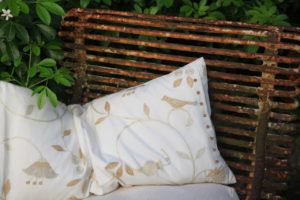An ancient embroidery technique that creates a continuous chain stitch on the top with small straight stitches beneath, and is typically embroidered in silk or wool onto cotton or wool. It can be worked with the thread on top of the work using crewel needles, or in The Persian manner with a hook, an ari, that brings the thread from the back and up through to the front.
Image from Calluna : Cushions – Heather Luke
A simply worked crewel design in soft colours- beaded amber glass beads at the side pick up the delicious creme and spun caramel colours….
* Crewel work has been made for centuries and traded since at least the 14thC along the oldest trading routes from China through India, Persia, Turkey and into Europe. A similar technique to tambour lace the wonderful suzani from Uzbekistan are worked with ari chain stitches ; the largest hand made rug in the world was made in Gujarat by this method in ari work and is now housed in the Marangarth Fort – Jodphur museum
* The Turkish used this stitch to make elaborate embroidery works, often for bedcovers, often with gold and silver threads. Peruvian Indians have a similar technique, though worked without a frame.
* It is also the stitch that worked the Bayeux tapestry, and which became popular in England in the late Elizabethan and Jacobean era for heavy curtains, bed hangings and bedcovers. Crewel work bedcovers were prized and special–a bed might be hung in a plain silk or wool and the bedcover be the star feature, where the heart-warming colours, design and work would best be displayed.
* The east India trading companies brought Eastern crewelwork panels and lengths of fabric to European 18thC middle-class households. It’s difficult for us to realise just how exciting and exotic it was to see and to own these multi-coloured, floral textiles. How anxiously the women must’ve waited for the next shipments to have this textile in their lives.
* Today, the most beautiful crewel worked fabrics on the market are much simpler and predominantly made in Kashmir. Kashmiri crewel is either worked with a hooked needle–an ari–or with crewel needles, or with both. The work is most often made of wool threads embroidered onto a cotton base cloth; however, this stitch-work can be applied to any material and with any thread to create fabrics with depth and dimension.
* Chain stitch can be worked on it’s own to create the whole pattern or in combination with split stitch, satin stitch, stem stitch, couching and French knots for incredibly complex designs.
* The designs are worked with flowing lines of chain stitches, which either reverse and turn to fill the leaves and floral or other motifs, or form the outlines ready for other stitch work to infil.
* The ari stitch looks like chain stitch but is worked in a different way. From the back, the work shows a short line where each stitch has been made (with chain stitch there is small gap between each stitch).
* The right hand holds the frame or the work and the left hand holds a line of thread beneath. The ARI is inserted from above, catches a thread from beneath the fabric and a loop is pulled through the fabric. For the next stitch, the ARI is inserted at the midpoint of the first loop and a second loop is pulled through. The process is repeated to create a continuous line of chain stitch.
* As with sewing needles, different sizes of ari are used for different fabrics and fineness, varying in size with the project.
* The work is sometimes held free, but is more commonly fixed on a large frame with more than one person working on a single width of cloth, sitting side by side and opposite each other.
* The cotton base cloth is plain weave or sometimes hopsack, usually unbleached.
* Tones of white-on-white are very elegant and really can suit any style of home– as curtains, cushions, loose covers, bed hangings and bed covers. In addition, white on a plain dyed base cloth, vice versa and many multicoloured options from millefiori to tropical jungle designs are created for the international market.

